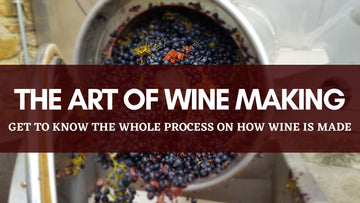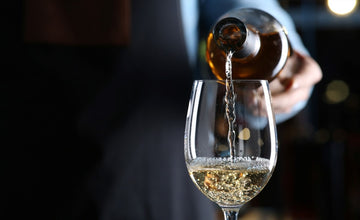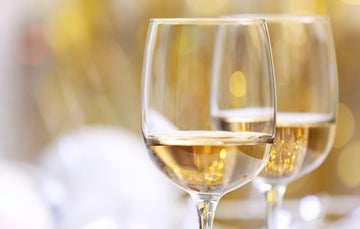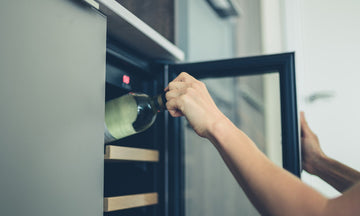
For ages, wine has been a component of human society, and making wine is an art form. From grape harvesting to bottling, there are numerous phases involved in the winemaking process. The most crucial stage is fermentation, which turns grape juice carbohydrates into alcohol. The sort of wine produced is determined by how long the grapes are fermented. Different grape kinds, yeast strains, and acidity levels can all have an impact on the flavor and qualities of the wine.
Here's a quick overview on how wine is made:
1) Choosing the correct fruit is critical to the success of the wine-making process. When selecting grapes, a range of parameters such as sugar content, acidity levels, and maturity should be considered. For red wines, the fruit should be picked at an advanced stage of ripeness with high sugar content.
2) After the fruit has been harvested, it must be crushed to obtain the juice. This can be accomplished either manually or mechanically. The resulting juice will next need to be fermented in order for the sugars to be converted into alcohol.
3) Different types of yeast are added during fermentation to control how quickly and effectively the conversion occurs. Different yeasts will give the finished product different flavors, smells, and textures. Temperature and oxygen level are also important factors in fermentation since they affect the rate of conversion.
4) Once fermentation is complete, the wine can be aged. Depending on the type of wine, aging can last anywhere from a few months to several years. This method allows for the development of mellow flavors and aromas as the tannins soften and the acidity levels decrease.
5) Finally, the wine is bottled and sealed with a cork - or some other type of closure - so that consumers can enjoy it. The vintage year, grape variety utilized, winery name, and other information are often included on the bottle labels.
Commonly Asked Questions:
Q: What is the most crucial phase in the winemaking process?
A: The most crucial phase in the winemaking process is fermentation, which turns carbohydrates in grape juice into alcohol. Different grape kinds, yeast strains, and acidity levels can all have an impact on the flavor and qualities of the wine.
Q: How long should grapes be fermented for a certain variety of wine?
A: The type of wine produced is determined by how long the grapes are fermented. Red wines often need more time to ferment than white wines. This time frame can, however, be influenced by the yeasts utilized during fermentation.
Q: Why is aging vital in the production of high-quality wine?
A: Aging is vital because it enables for the development of mellow flavors and aromas as tannins soften and acidity levels fall. varying varieties of wines require varying age times, thus winemakers must account for this when creating their product.
Q: How should I store wine?
A: Wine should be stored in a cool, dark place away from vibrations and temperature variations. It is also advisable to store opened bottles of wine upright to prevent oxidation. This will help to keep the quality of your wine intact.
Q: What information should be put on a wine label?
A: Wine labels often include information such as the vintage year, grape variety utilized, winery name, and other data. They may also provide taste comments and food match ideas, depending on the style of wine. Some labels will even identify the wine's awards or provide specific information about the winemaking process.
Q: How can different yeast strains affect the flavor of wine?
A: Different yeasts provide different flavors, smells, and textures in the final product. Some yeasts, for example, might give fruity or flowery notes to wines, whereas others can provide peppery or earthy flavors. Winemakers must select the appropriate yeast strain to achieve the desired characteristics in their wine.
Q: What is the distinction between red and white wine?
A: The primary distinction between red and white wines is how the grapes are handled. Red winemakers select ripe fruit with high sugar levels, whereas white winemakers select fruit that has not yet achieved peak ripeness. Red wines are also aged for extended periods in order to acquire complex characteristics. White wines, on the other hand, do not require as much age and can be consumed soon after fermentation is complete.
Q: What is the secret to producing superb wine?
A: Finding the proper combination of excellent ingredients, meticulous attention to detail in each step of the winemaking process, and patience for tastes and aromas to develop over time is the secret to crafting a wonderful wine. Winemakers must also experiment with various procedures and grape kinds to determine what works best for them. Any prospective winemaker, with enough practice, may produce a genuinely excellent product.
Q: What effect does temperature have on winemaking?
A: When it comes to winemaking, temperature is one of the most essential aspects. Temperatures that are too high or too low can cause spoiling, thus temperature control is essential during the fermentation, aging, and bottling processes. Furthermore, cooler temperatures will slow down the fermentation process, while warmer temperatures will speed it up; this must be considered when determining how long grapes should be fermented. Finally, a winemaker's skill consists in maintaining perfect circumstances throughout production in order to achieve a good and delectable result.
Q: What is the secret to excellent grape mixing for wine?
A: Understanding how each grape type adds to the flavor, aroma, and texture of the completed product is the key to successfully blending different grape kinds when making wine. When mixing different varieties, winemakers should consider both complementary and opposing traits in order to create a well-rounded taste with depth. Furthermore, while modifying sugar levels, acidity, and tannins during fermentation and age, great attention must be paid - these modifications can make all the difference in generating a wonderful end result. Any winemaker may learn how to build an amazing grape mix with practice and experimentation.
Conclusion:
Making wine is an art as much as a science. Anyone, with the correct information, abilities, and procedures, may develop their own unique blends that are tailored to their specific tastes. The key to success is to use high-quality ingredients, pay attention to detail at every stage of the process, and be patient as tastes develop over time. Any prospective winemaker can refine their craft and become a successful vintner via trial and error.
Tags:






